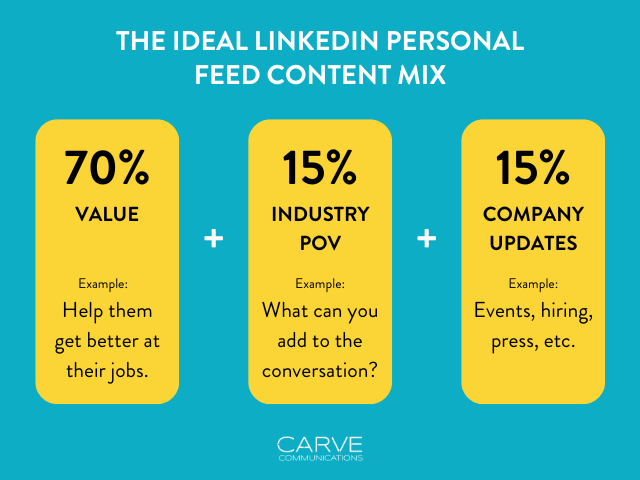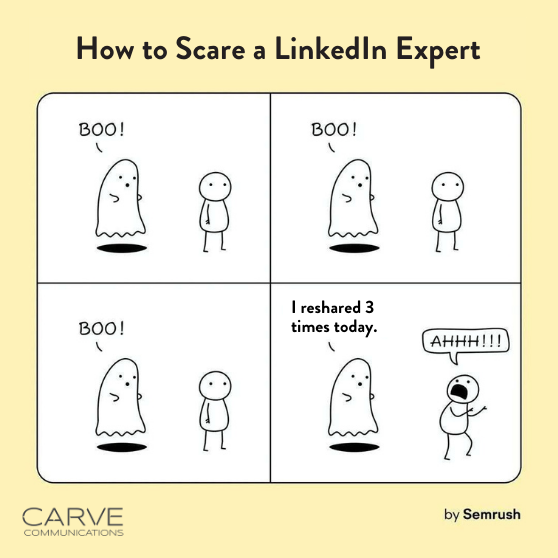Our Executive Playbook for LinkedIn Thought Leadership: Tips, Landmines, Strategies
Refreshed September 2024
Growing up, my uncle taught me how to play chess. It was our bonding activity.
I’m not a good player now and have forgotten many – if not most – of the moves he taught me, but there’s one lesson I do remember:
The king piece on the board is also a player.
Many beginners see the king as a piece to protect but forget that it can also be used to win.
I can’t help but draw the connection between chess and thought leadership on LinkedIn.
The corporate LinkedIn feed isn’t the only channel to drive business goals. Don’t make the mistake of passing over a valuable player in your thought leadership strategy.
The king piece on the board — your executives.
Consumers have shown they actually feel more connected to a company when they follow and interact with the faces of that brand. And while there are many reasons to double down on LinkedIn thought leadership for executives, it’s not usually the “why” they struggle with.
It’s the “how.”
Having worked with many executives – now LinkedIn thought leaders with a little Carve help – we know what works and what doesn’t. Now, I want to share a little of that magic with you.
A Glimpse Into Our Executive LinkedIn Strategy
There’s a Story Behind Every LinkedIn Leader
We kick off the first conversation with our LinkedIn executive clients by saying this:
“We’re the communications experts. You’re the industry expert. We know how to tell the story, but you know the right story to tell.”
The opposite is also true: industry experts are (usually) not communications experts. And one of the most common pitfalls we see in an executive LinkedIn strategy is completely ignoring “story” altogether.
The truth is, LinkedIn storytelling is the most successful tool in your arsenal. Humans are hardwired for it. Every personal anecdote or picture you share touches something in someone else.
For example, when I came across this post, I immediately wanted to read the rest.
I’ve been criticized in public before so that first line caught my attention. In a rare moment of interest, I didn’t skim. I read the post all the way through. Why? Because I connected with the story.
Getting personal on LinkedIn also doesn’t mean you need to waive your right to privacy. You can let your audience in on what matters to you without telling them everything.
Start by asking yourself questions like:
What am I most passionate about day-to-day? (Your answer doesn’t have to be restricted to work. We wrote a post about why a client collected sneakers and it took off!)
What were a few career-defining moments for me, and why?
Who were my mentors? Did they tell me any hard truths, or help pivot my thinking?
What do I wish more people knew about my industry and why?
What’s important to me? How does my role connect to that?
Follow each of these questions by “why” and “so what?” Answering those questions will help you understand why your audience might care about it, so you can amplify that value.
Now, use all that information and paint a picture for your audience. Use your words to weave the story together, rather than just telling them a play-by-play.
Don’t Leave Your Personality Behind
Here’s the second thing humans are hardwired for: connection.
Which is why starving your LinkedIn feed of personality is dangerous. If you’re boring, nobody will connect with your content or the person behind it. (Trust me when I say this – you’re not boring.)
There are some practical ways to incorporate your personality into your feed:
Write like you. Use phrases you might say out loud. Don’t try to sound fancier than you actually are. (Some advice: Nobody likes corporate jargon, so use this AI tool to catch and remove buzzwords from your posts.)
Share your provocative opinions. If you find yourself thinking “I wish someone would have told me X,” or “There’s an ugly truth no one wants to acknowledge,” it might be a good social post.
It’s okay to share a fun post for the sake of fun. There’s a lot of business on LinkedIn — sometimes people just want to see something lighthearted.
Speaking of… try humor or a meme. Lighten up your feed a little.
Memes do great on LinkedIn if you’re trying to make light of a repeated frustration or problem in the industry. The good news is that you can find them everywhere.
I find the best places are other industry thought leaders on LinkedIn, Twitter (or whatever alternative platform you’re choosing to use now), Know Your Meme, or Imgur. You can easily find animated memes – or gifs – on websites like Giphy.
If, like in the example above, there’s a picture that you want to add more specific text to, Canva is a low-cost, user-friendly option. It’s also a great tool to create graphics to layer into your LinkedIn thought leadership strategy. A visual aspect added to posts is always helpful if you’re looking for new strategies to book audience engagement.
Pro Tip: It’s easier to find unique, sharable content– whether a meme or an article – than you think. We put together a guide on our own content curation process to help you source and share content relevant to your expertise and audience.
Jump Into Trending Conversations
Similar to trend-jacking with the media, if there’s a popular topic on the Internet, there’s a great opportunity to showcase your expertise or relevant opinions. Evaluate what you have to offer to the conversation: it might be a differing opinion, a question, an elaboration, or a similar experience — take it to LinkedIn.
For example, Airbnb’s co-founder and CEO dished out an interesting opinion on a podcast, which the Internet called “founder mode.” The term, and the idea behind it, exploded overnight and we worked with clients to quickly share their thoughts on founder mode:
Sharing your commentary on recent thought leadership articles is another good way to showcase your industry knowledge. When we create content for clients, we closely follow their favorite LinkedIn leaders and publications they like to read to see if something comes up. We also set Google Alerts tied to the anchor topics we agreed on in our Foundational Content Document. Then, as email alerts pop up, we see if there’s something we can react to.
Pro Tip: Take advantage of LinkedIn’s trending topics on the right side of your home feed. You might find news pertinent to your role, industry, or business and can see what others have shared there, too. Use this information to develop your own POV in a post.
I also like to think about seasonality. Many industries often go through cycles. If you’re in the sports industry, each season or year brings new events like March Madness or the World Cup. If you are a finance leader, you might tie content to financial close periods or other reporting deadlines.
There are also holidays like National Take Your Dog to Work Day or National Coding Week. Make a list of these events and holidays and see if you can turn them into an opportunity.
Things to Avoid in Your LinkedIn Strategy
Mistake #1: You’re Overly Promotional
Your business goals should be a factor in your LinkedIn strategy. However, there is no better way to lose your audience than being too self-promotional — it’s a balance.
To know if your feed is overly promotional, look at your last 10 posts. How many of the following pop up?
Registration or promotion for a company event
Hiring post
Company announcement
If the majority of those posts are self-promotional like the above, it’s time to mix it up. All those things are great, but you don’t want them to be the bulk of your feed.
You want to concentrate on communicating value, which means understanding your audience — and then delivering on that by sharing what they need. What will help them get better at their job? Is there something that could make them happier? Think wisdom, tips, or a new perspective.
Pro Tip: If you’re an active thought leader in channels besides LinkedIn, repurpose what you can from those sources. Think anecdotes from media coverage or tips from speaking engagements.
When we create content for potential clients – and our own LinkedIn feed – we go by a rough equation.
YOUR LINKEDIN FEED = 70% VALUE + 15% INDUSTRY POV + 15% COMPANY UPDATES
Why so much focus on value?
Here’s the simple answer: Value keeps people reading your content, engaging with your feed, and interested in you and your offering.
When you meet someone for the first time, you don’t immediately launch into a reel of your life’s greatest accomplishments. (If you do, you might rethink your people strategy.)
You start by introducing yourself, who you are, and what you do. You get to know the other person and what they need from you. You build a relationship. Then, when you inevitably have wins to celebrate, the other person knows and trusts you enough to celebrate with you.
It’s the same for your LinkedIn storytelling.
Mistake #2: You’re Not Engaging
One of the worst things you can do is to spend time creating and posting content, but don’t engage with your audience. LinkedIn is ultimately a social media platform. Meaning, the more you connect with your audience and network, the more favorably the algorithm will view your content.
It’s a red flag to the algorithm when you post and ghost and decreases the visibility of your posts in others’ feeds. After posting, stay and interact with other creators in your home feed.
We counsel clients to set engagement goals for themselves. It could be spending five minutes every morning engaging on LinkedIn; it could be fifteen minutes every other day. Whatever your goal is, stay consistent. That’s how you will see results.
At the bare minimum, you should respond to comments on your posts. Doing so shows that you’re not just in the LinkedIn game for the follower count; you’re there to participate in a community and engage in conversation.
If you’re at a loss for how to interact with other posts, here are a few things to think about:
Do you have a similar experience to talk about?
How does this post make you feel? Were you surprised or unsurprised?
Do you disagree? Don’t stop there — explain your thoughts.
Know someone else who might enjoy the post? Tag them in the comments!
Mistake #3: You Don’t Sweat the Small Stuff
This is where we launch into the nitty-gritty. The LinkedIn algorithm is a tricky, finicky creature full of contradictions that many don’t discover until they’ve spotted a pattern.
Case in point: LinkedIn will boost your post if it sees that others are re-posting it. But if you directly repost someone else’s content with a few lines of original copy, it limits your post’s reach.
Why? Because the algorithm is positioned to boost original thought leadership, rather than riding the coattails of someone else’s opinion.
But we see LinkedIn leaders make this mistake All. The. Time. We’ve seen it so much that we dedicated a social post on Halloween to it:
We’re not telling you to stop reposting. In fact, reposting can be great if you want to show support for another creator without being concerned about reach.
We’re asking you to think about it differently. Work around the algorithm by screenshotting what we want to re-post and uploading it like a picture. You can then write your own dialogue into the post and tag the original creator (more rules on that below).
Here are a few more things we’ve learned:
Tagging profiles or pages that never interact penalizes your post. It’s a good idea to only tag those you’re certain will interact and give them a heads-up before you publish.
LinkedIn prioritizes video with a “TikTok-like” feed in the app. Figure out how to lean into more vertical videos, while still keeping your content professional and insightful.
Fewer people are online on Fridays, so those days shouldn’t be part of your normal posting schedule. If you do post on a Friday, publish before lunch and make sure it’s a fun or undeniably timely one!
If you publish with a link that takes a viewer outside LinkedIn, the reach of your post will be penalized. Instead, publish your post without it, then hit edit and drop the link in directly after. Since you’re making a small change, the algorithm will look the other way.
We won’t give away all our secrets, but you get the point. There are a lot of algorithmic land mines you can step on without knowing it.
Should the algorithm dictate everything you post? Absolutely not.
But there’s nothing more disheartening than investing time and effort into a post you think will take off… but flops because of something small you didn’t know to avoid.
We know this is a lot to take in, and – frankly – it’s only the tip of the iceberg. Like good chess players, we’re constantly researching, trying out new techniques, and tweaking our strategy.
The “LinkedIn Executive Playbook” changes a lot, as it should. But this should give you some solid ground to start.
When in doubt, remember this: you already have the expertise. All you have to do now is let that shine through.





